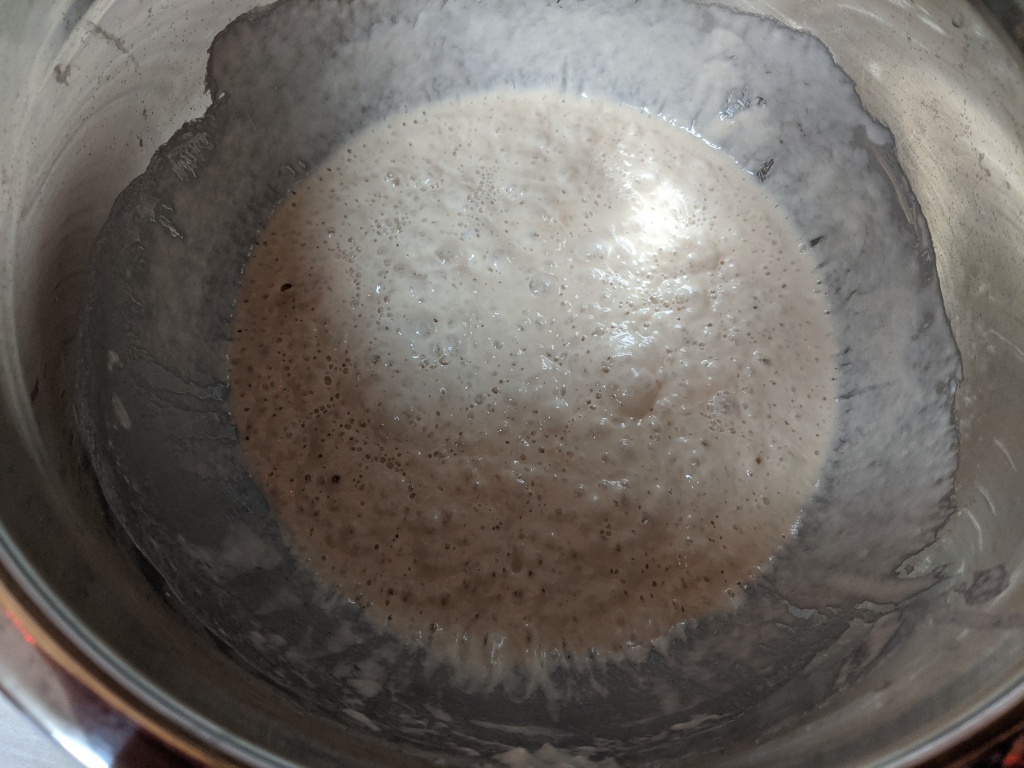This Thanksgiving was a bittersweet holiday for many, my family included. The challenges of navigating a holiday season during a pandemic necessitated that we stay put in Texas for Thanksgiving, rather than traveling to see our extended families. While this made for a quiet day, it was still a sweet one of celebrating our baby’s first Thanksgiving, thanking God for all of His blessings, and eating good food, of course.
My husband lovingly made all the turkey and side dishes, while I contributed the baked goods to our feast. (Of the two of us, he’s the better cook by far – to provide an example, I’ve been known to burn scrambled eggs, so I just stick to the baking usually). In addition to making a pumpkin pie, I decided to try out a recipe for 18th century French rolls, posted by Colonial Williamsburg on their Facebook page. The rolls took a good deal of time, most of which was just waiting, but they were well worth it! There’s nothing quite like the smell of fresh baked bread wafting through the house and building up one’s anticipation for a tasty meal to come! I had to make a number of adjustments to the recipe, so keep reading to find out what worked (and what didn’t work!).
First, I had to make a sponge (for a super simple explanation of what a sponge is, you can check out this article from Project Pastry Love). The recipe from Williamsburg says to mix 1 cup of warm water with 2 teaspoons of yeast, and 2 cups of flour to form a pancake-like batter. However, my mixture was much thicker than pancake batter, so I added about 1/3 to 1/2 cup more of warm water, which seemed to work just fine. Then, I covered the yeasty goop with plastic wrap and set it on the counter to ferment for the next 12-16 hours.

By the morning, the sponge was bubbly and, as Williamsburg’s recipe indicated would happen, smelled slightly like beer.

The next day, I finished mixing up the dough after our traditional Thanksgiving morning breakfast of donuts. To the sponge, I added 1 cup of milk, one beaten egg, and 1/2 cup of softened butter. Then, I worked in the remaining 2 cups of flour; however, the dough was far too sticky, so I continued adding more flour a little at a time till the dough was manageable enough I could turn it out of the bowl and onto the counter for the kneading process. At this point, the dough was still too sticky, so yet more flour was added again and again till the dough was workable and kneadable (though still a little sticky). The recipe called for 20 minutes of kneading, but I kneaded for about 30 minutes (trust me, if you’re looking for a new arm workout, try kneading dough for 30 minutes!). By kneading longer, I was hoping to get the dough to the window pane stage, as my fellow fans of The Great British Bake Off will understand. But, a fussing, hungry baby meant that I quit kneading at 30 minutes and set the dough in a greased bowl covered with plastic wrap for its first rise.
While the recipe said to let the dough rise for 1.5 – 2 hours, or till double, my dough was doubled only 1 hour into the first rise. At that point, I turned the dough out onto the counter, divided it into two parts, and then divided each half into 8 portions, for a total of 16 little doughy buns. Covered with yet more plastic wrap, buttered this time to prevent sticking, the little balls of pillowy goodness started in on their second rise, which lasted for only 30 minutes.

The recipe said to bake the rolls at 400 degrees Fahrenheit for 30-35 minutes. Since I have a fear of over-baked bread, I set the timer for just 15 minutes at first, when I rotated the baking sheets in the oven to try to achieve an even bake and color. I then gave the rolls 10 more minutes, but pulled them out after about 8 more minutes in the oven, since they had a nice golden brown color and the internal temperature registered about 200 degrees. So, that made for a total of 23 minutes in the oven, in contrast to the longer baking time indicated by the recipe.
I am not ashamed to admit that my husband and I nearly burned our fingers splitting a fresh from the oven roll in two to sample. The rolls had a nice chew, and a simple but delightful flavor, well suited for accompanying a delicious Thanksgiving meal! While they turned out to be rather large rolls, I think making them smaller (and also reducing the baking time if making smaller rolls) would work quite well. I’ll admit that two adults and one very small baby don’t really need 16 rolls, but I think they’ll make rather nice, if somewhat large, Thanksgiving leftover sandwiches, as well as a pleasant side for turkey soup.

Per Williamsburg’s recipe and the video they posted along with their recipe, rolls were most often served at only wealthier homes, whereas lower classes would eat loaves of bread. For the upper classes, rolls would be neatly wrapped in their napkins when they arrived at the dinner table, with the understanding that the roll would be used for wiping up excess sauces and crumbs from their plates. My husband and I didn’t wrap our rolls into our napkins prior to eating dinner, but they were a welcome addition to our Thanksgiving feast!
Citations
Historic Foodways. “French Bread.” Colonial Williamsburg. November 17, 2020. https://colonialwilliamsburg.org/learn/recipes/french-bread/?utm_campaign=recipes&utm_content=1605629002&utm_medium=social&utm_source=facebook&fbclid=IwAR2EoKzZrbw332jdJnQ1cOv1R1Jumpt8pFeMfXVhJIc5PKEXF4SjfZMmE5s.
Colonial Williamsburg. “Want rolls on your Thanksgiving table fitting of the Governor’s Palace?”. Facebook. November 19, 2020. https://www.facebook.com/ColonialWilliamsburg/photos/a.177637929575/10158135294474576/.
Liz. “The Sponge Method (not that sponge method) in Bread Baking.” Project Pastry Love. May 22, 2014. https://www.projectpastrylove.com/the-sponge-method-not-that-sponge-method-in-bread-baking/#:~:text=The%20Sponge%20Method%2C%20aka%20Yeast%20Starter%20or%20Yeast,a%20thick%20batter%2C%20also%20known%20as%20the%20Sponge.
